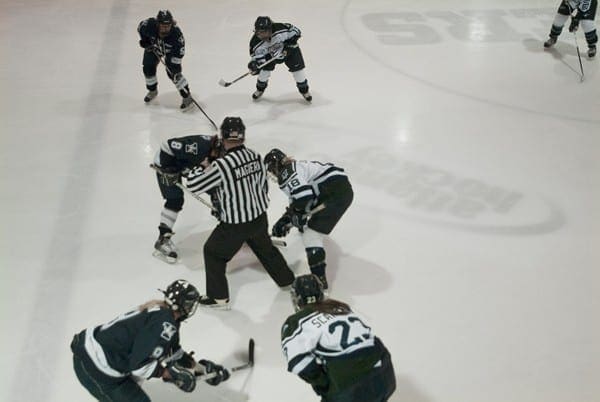Photographing a Public Event

One of the more difficult tasks to prepare for photographing an event is to verbalize what you want to say, and then figure out who the audience is. It is good to start with some clear ideas of what you want from the shoot, and what you think you might find there- or hope to find there…
Of course when you arrive at the location, all those plans and thoughts can fly out the window!
1. Think Ahead. What is the event you want to photograph and how do you plan to approach it with your camera?
In this case it is Mercyhurst College Women’s Ice Hockey, but you could find yourself photographing a parade, sporting event, a school play or a neighborhood. For the Ice Hockey team, the destination of the photographs was the website of the Pennsylvania Project. (www.thepennsylvaniaproject.com). I knew I would have to have at least 10 images for final use, and that I would in fact be pairing these images with another photographer. That means that my images would ultimately have to work with someone else’s. Some of my great (!) images might not work, and I would need a lot of images to choose from.

2. Take a lot of photographs! Documenting an event that you don’t have control over means that you will have some hits and some misses.
It also means that I wanted access to many aspects of the team’s training and the game itself. I contacted the Athletic Director, Coach and Sports Information Department at Mercyhurst College and told them what I wanted to do. I have found that by calling ahead, I can often get much better access than if I just show up.

3. Call ahead and let the “authorities” know that you plan to take pictures, so you can get the best possible location and angles.
I arranged to photograph team practice, team meals, the pep talks in the locker room, the game and the after the game locker room round-up. I arrived in Erie in time for a Friday afternoon practice, and stayed for the Saturday afternoon big meal and coach’s discussions. I attended the game Saturday night, and went to the locker room before and after the game.

4. Include yourself in as many aspects of the event as you can!
Just as athletes need to practice and warm up, the same is true for photographers, especially when in a new location. I photographed as the team warmed up before the game, checking my white balances, how my cameras would respond in a cold ice arena, and how many layers I needed to wear. I needed to refresh my eyes and shutter finger to the speed of ice hockey. I needed to check out the arena and see how many available locations there are to photograph from. I found several angles, and discovered that it is a relatively warm arena.


5. “Warm Up!” Arrive Early. Before the event starts, take a few practice shots.
I followed the game action from several angles, and spent some time with the crowds. At half time when the home team was losing, I stayed out of the locker room. I thought they did not need the distraction of a stranger with a camera, and that whatever pictures I might make in there would not be worth the thought of seeing them loose and wondering if I was too big a distraction. There would be access after the game, win or loose.

6. When you go out to photograph an event think about the impact you bring to it.
Think about what you want and how to get it. Think about what your audience might like to see to. What do they need or want to know? Can you leave some blanks for the audience to fill in so they have some fun of discovery as well? Then add it all up, balance it out so it makes sense for everyone, and mostly be sure to have a great time!




